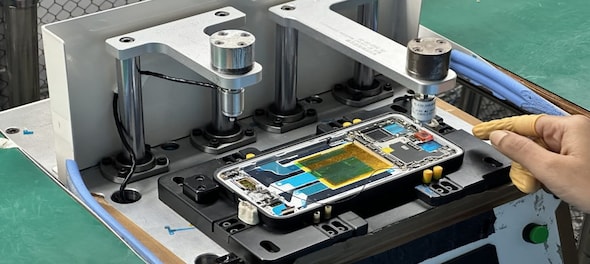
I recently got to tour the Nothing manufacturing facility in Chennai, where the company assembles the Phone (2), and it was a unique experience.
As a tech reviewer-slash-writer-slash-reporter, I review dozens of smartphones each year — and it's an absolute delight. Each smartphone, especially in the Android world, is like a Baskin Robbins ice cream flavour — it's distinct, it's quirky, and, depending on the brand, has different value propositions, be it the camera, the battery, the build quality, or a unique design.
But that's about as far as I can get. I'm no Zack Nelson — the face of and the soothing voice behind the YouTube channel Jerry Rig Everything. Zack, on his channel, is brutal on his test devices — he sets them on fire, breaks them, and takes them apart, just to see how the device is built and whether the brand's claims hold up. The most I can do is test the smartphone based on its features, stress-test the battery and the operating system over a few weeks, try out the cameras and deliver my verdict. The loaner smartphone then goes back to the brand, and, that's the end of the story. I don't have the chance to get my hands bloody by plunging into the device's innards.
But to see how a smartphone is assembled from scratch is something I've always wanted to see, but never had the chance. Till now, that is.
When Nothing invited me to tour its facility, I naturally jumped at the chance to see how the sausage gets made. This was especially interesting to me because Nothing has had to train its workforce to assemble a transparent, design-led smartphone, which is different from how other phones are manufactured.
First things first, I had to wear two layers of protective suits — one a jacket that looks like a regular raincoat, a cap, and shoe covers; and the full-body hazmat suit, including a hoodie with a drawstring, and a pair of protective covers for my feet. The first was for when I toured the pre-assembly line, and the second, worn over the first layer, is for the actual assembly line. This was to ensure no foreign particles entered this sensitive area, where the Phone (2) is put together — the motherboard, the radio frequency module, the front and back cameras, and the back glass.
As you might know by now, the Phone (2), with better ergonomics, a powerful processor and better everything, is a welcome upgrade from the well-received Phone (1). But the difference this time around is that Phone (2) is manufactured entirely in India, while its predecessor was assembled.
So, upskilling the operators and technicians — especially for a design-led product like the Nothing Phone — took time and effort. And from what I saw, it was a well-oiled machinery — each operator was deliberate, never hurrying through the process and took their time to examine the phone, both manually and with the help of machinery, to ensure it goes to the next stage fully ready. This held true from the pre-assembly line to the actual assembly, to the packaging process.
Let me now take you on a literal tour of the facility.
Before I entered the facility, I had to pass through two air chambers, which blast air at you from all angles to remove any dust and foreign particles from the exposed parts of your body.
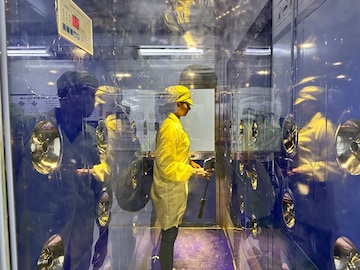 The first air chamber. (Image: Vijay Anand)
The first air chamber. (Image: Vijay Anand)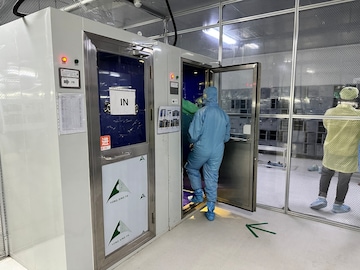 The second air chamber. (Image: Vijay Anand)
The second air chamber. (Image: Vijay Anand)And then you enter the mothership.
Pre-assembly
This is where the mid-frame (the aluminium frame and the chassis) and the touch panel are prepared. It's an elaborate process, and according to Nothing, which manufactured the Phone (1) at the same facility, upskilling the workforce to manufacture its successor was the big challenge. Once that was accomplished, manufacturing the Phone (2) was a breeze, figuratively.
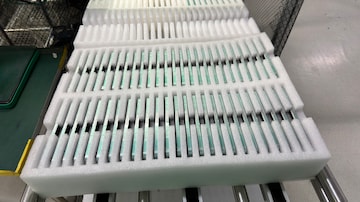 The mid frame of the Nothing Phone (2) pre-assembly. (Image: Vijay Anand)
The mid frame of the Nothing Phone (2) pre-assembly. (Image: Vijay Anand)As I walked from start to finish, I first saw the mid frame and the underlying chassis being checked for any imperfections. Then the touch panel was attached. Each unit went through rigorous checks — an operator would first check manually, and pass it on to a colleague who would then put the device under a microscope to ensure the glueing pattern is uniform. The device is then put inside a plasma steriliser machine, which gets rid of all microorganisms and, as the name implies, sterilises it.
 A technician checks for defects under a microscope in the pre-assembly process. (Image: Vijay Anand)
A technician checks for defects under a microscope in the pre-assembly process. (Image: Vijay Anand)The unit is then passed along, where it is placed in a pressurised box, which applies constant pressure for three hours to ensure the glue sticks.
The device is passed along the line for multiple other checks before it is sent to the assembly line.
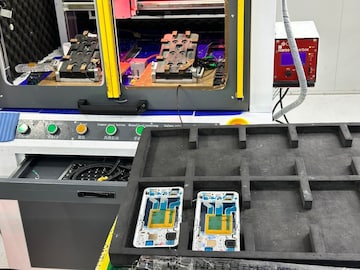 (Image: Vijay Anand)
(Image: Vijay Anand)Assembly
This is where things get really interesting. It was fascinating for me to see what was an empty aluminium and glass shell come to life as the Phone (2).
Each stage of this process is accomplished inside a 'clean booth,' which is a protected compartment to ensure no dust enters while the Phone (2) is being assembled. According to the floor manager, this is especially important as dust, which may not functionally impair the smartphone, will stick out like a sore thumb in a transparent phone. Below the clean cabins are water beds — essentially trays with water, to further trap dust. These water beds are refreshed every hour. Further, to leave nothing to chance, there are humidifiers in each clean cabin to further reduce any chance of rogue dust particles making it in.
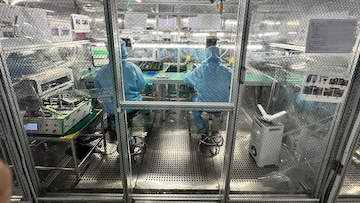 A clean booth in the assembly line. (Image: Vijay Anand)
A clean booth in the assembly line. (Image: Vijay Anand)The motherboard — which is manufactured in a different facility and transported to this one — is first attached to the chassis. Next up is the wireless charging coil. After that, the RF components are attached, followed by the rear and front cameras, speakers and all other components vital to the smartphone experience.
 The Nothing Phone (2) motherboard. (Image: Vijay Anand)
The Nothing Phone (2) motherboard. (Image: Vijay Anand) A technician installs the rear camera array on the Phone (2). (Image: Vijay Anand)
A technician installs the rear camera array on the Phone (2). (Image: Vijay Anand)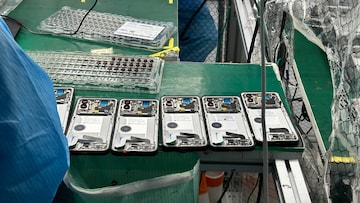 The front camera is being installed here. (Image: Vijay Anand)
The front camera is being installed here. (Image: Vijay Anand)The by-now-iconic Glyph Interface is the final touch. The lighting strips are very delicately attached to the back of the phone and then tested for any defects.
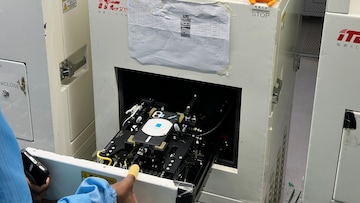 The installation of the Glyph Interface. (Image: Vijay Anand)
The installation of the Glyph Interface. (Image: Vijay Anand)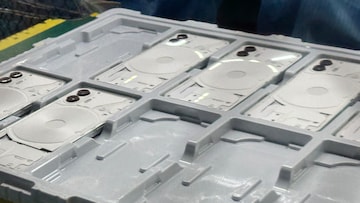 The Glyph lights are tested after installation. (Image: Vijay Anand)
The Glyph lights are tested after installation. (Image: Vijay Anand)Finally, the device goes to the final section, where it is thoroughly checked for any defects or inconsistencies before the back glass is glued on.
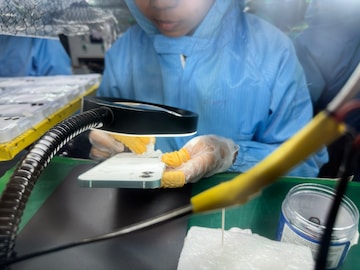 A technician checks the back of Phone (2) for any imperfections or defects before the back panel is installed. (Image: Vijay Anand)
A technician checks the back of Phone (2) for any imperfections or defects before the back panel is installed. (Image: Vijay Anand)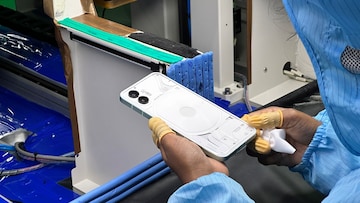 A technician checks the Phone (2) after the back panel is installed. (Image: Vijay Anand)
A technician checks the Phone (2) after the back panel is installed. (Image: Vijay Anand)From a disparate collection of parts to a fully assembled phone, it was quite the experience to walk along as it came together to resemble one of my favourite smartphones of the year. Of course, at this stage, the phone is being tested on factory firmware — Nothing OS 2.0 will be installed at a later stage.
At the time of my visit, the demand for the white variant was high, so only this was being assembled. According to the floor manager, as and when demand for the dark grey variant picks up, they will start assembling it at the same plant — this is the only facility in India where Nothing manufactures the Phone (2).
The assembled phones are then sent to a temperature-controlled 'aging' room, where they are plugged into chargers, with the Glyph Interface on, for eight hours to ensure they can withstand the heat that is generated both from charging and the Glyph lighting.
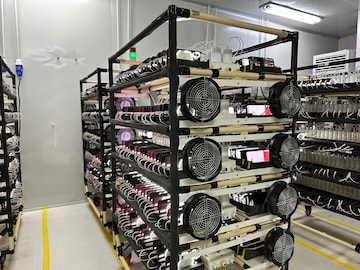 Devices are plugged into chargers, with the Glyph Interface lit up, for eight hours straight in an 'aging' room.
Devices are plugged into chargers, with the Glyph Interface lit up, for eight hours straight in an 'aging' room.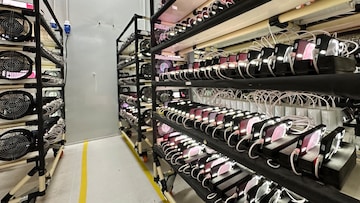
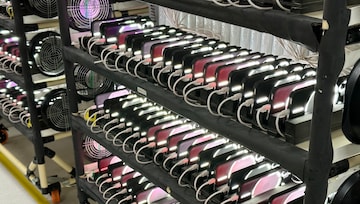 More images from the 'aging' room.
More images from the 'aging' room.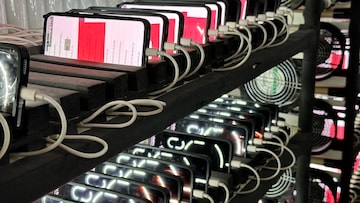 Nothing OS 2.0 is installed only at the packaging stage. (Image: Vijay Anand)
Nothing OS 2.0 is installed only at the packaging stage. (Image: Vijay Anand)Packaging
While this may sound mundane, this was no less fascinating. Nothing's packaging is completely plastic-free, and each device is given one final check before being put on the conveyor belt. At different steps of the process, the charging cable, the SIM ejector tool and accompanying literature are placed inside the box, which is finally weighed.
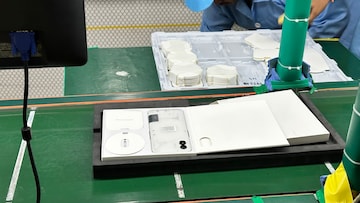 The SIM ejector tool and charging cable are placed in the packaging. (Image: Vijay Anand)
The SIM ejector tool and charging cable are placed in the packaging. (Image: Vijay Anand)The operators know the precise weight of the package and any deviation from the norm will let them see if any part of the packaging is overweight or underweight.
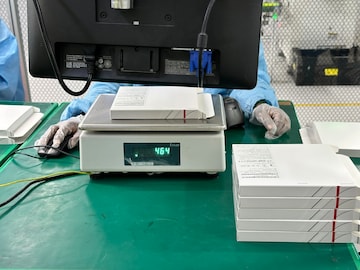 Each package is weighed precisely to ensure no components are missing. (Image: Vijay Anand)
Each package is weighed precisely to ensure no components are missing. (Image: Vijay Anand)Finally, the package is sealed, and the Phone (2) is ready to be shipped.
In conclusion
What I witnessed was a smooth, deliberate process where each operator took their own time and didn't hurry. It helps that Nothing's output is nowhere as high (yet) as some other manufacturers — the company did not disclose the number of smartphones manufactured in a single day but did say the number varies depending on demand and the time of the year — festive season, pre-launch, etc.
Everyone knew what they were doing, no doubt a product of the time and money Nothing sank into the manufacturing process, and the result is a smooth operation in which the Phone (2) is meticulously put together.
If nothing else, this visit gave me a deeper appreciation for my Phone (2).
(Edited by : Shoma Bhattacharjee)
First Published: Oct 9, 2023 6:04 PM IST
Note To Readers
Nothing sponsored the reporter's trip to the manufacturing facility but had no editorial oversight or copy approval.
Check out our in-depth Market Coverage, Business News & get real-time Stock Market Updates on CNBC-TV18. Also, Watch our channels CNBC-TV18, CNBC Awaaz and CNBC Bajar Live on-the-go!


Supreme Court dismisses plea seeking postponement of CA exams; details here
Apr 29, 2024 2:29 PM
Just 8% women candidates contested first two phases of Lok Sabha polls
Apr 29, 2024 12:00 PM
The sexual assault case against Prajwal Revanna — here's what we know so far
Apr 29, 2024 11:36 AM
Repolling underway at one polling booth in Chamarajanagar LS segment in Karnataka
Apr 29, 2024 10:32 AM

